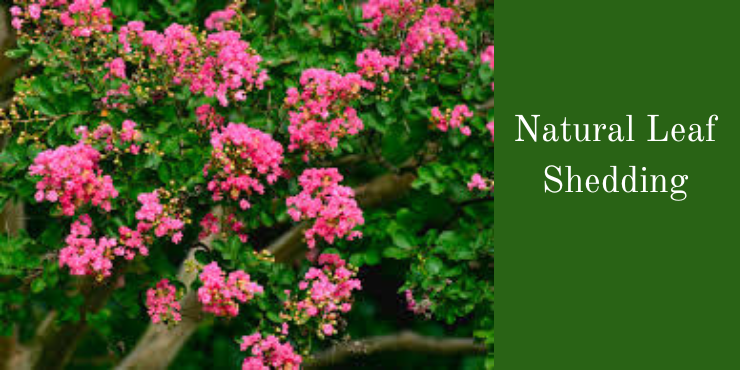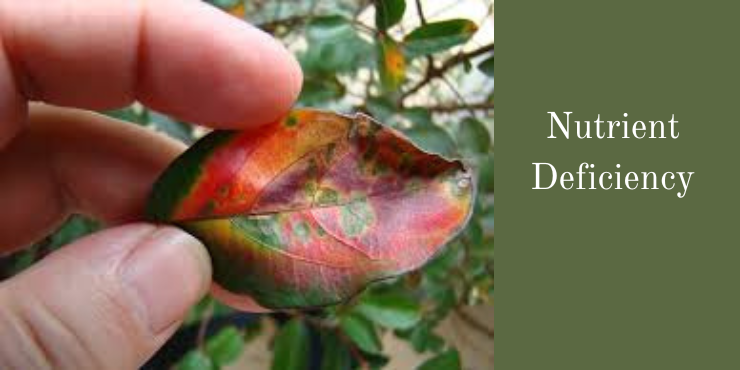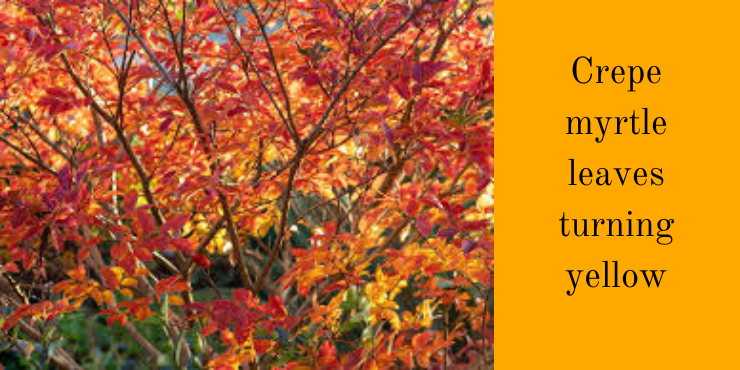How to Prevent Crepe Myrtle Leaves from Turning Yellow
Crepe Myrtle Leaves, scientifically known as Lagerstroemia, is a botanical wonder that graces gardens and landscapes with its enchanting beauty. Celebrated for its splendid blossoms, captivating foliage, and remarkable adaptability, crepe myrtle has earned a special place in the hearts of garden enthusiasts and horticulturists worldwide.
This remarkable plant is more than just a garden ornament; it’s a symbol of resilience and enduring beauty. With a rich history that spans continents and centuries, crepe myrtle has evolved from its origins in Asia to become a cherished addition to gardens across the globe.
In this article, we will embark on a journey to explore the world of crepe myrtle. We will delve into its fascinating characteristics, care guidelines, and the myriad of factors that can affect its health and appearance. Whether you’re a seasoned gardener looking to perfect your crepe myrtle Leaves care techniques or a novice enthusiast eager to learn more about this captivating plant, this comprehensive guide will provide you with valuable insights and tips to help you cultivate healthy, vibrant, and thriving crepe myrtles in your own outdoor spaces.
From the elegance of its crepe-paper-like flowers to the exquisite peeling bark that adorns its branches, the crepe myrtle is a testament to the beauty that can be found in the natural world. Let’s embark on this journey to uncover the secrets of this botanical treasure and discover how to care for and appreciate crepe myrtle in all its glory.
Understanding Crepe Myrtle
Before we tackle the issue of yellow leaves, it’s essential to understand the crepe myrtle itself. These deciduous shrubs or small trees are cherished for their vibrant flowers, which come in a variety of colors, and their attractive peeling bark. However, like all plants, crepe myrtles require proper care and attention to thrive.
Understanding the care and maintenance of crepe myrtle Leaves is vital to harnessing its full potential. Proper pruning, fertilization, and pest control are crucial aspects of crepe myrtle care. Pruning is essential not only for shaping the plant but also for promoting healthy growth and robust flowering. It’s essential to follow the correct pruning guidelines to avoid unnecessary stress on the plant.
Yellow Leaves: A Common Concern
The sight of yellow leaves on your crepe myrtle can be concerning, but it’s not uncommon. There are various reasons why this happens, and knowing the causes can help you address the issue effectively.
Yellowing leaves on crepe myrtle Leaves can be attributed to various factors. Firstly, it’s essential to recognize that these plants undergo a natural process of leaf shedding, which is entirely normal. As the seasons change, crepe myrtles prepare for winter by shedding their leaves, often displaying a breathtaking array of red, orange, or yellow hues in the fall. This transformation is a part of their annual cycle and should not cause undue concern.
Natural Leaf Shedding

One of the most common reasons for yellow leaves is natural leaf shedding. These deciduous shrubs or small trees possess the remarkable ability to undergo a seasonal transformation, marking the changing seasons in a garden or landscape. As the fall approaches, crepe myrtles gracefully begin to shed their leaves, contributing to the autumn tapestry of colors. It’s during this time that their lush green foliage transitions into vibrant shades of red, orange, or yellow, casting a mesmerizing spell on the onlookers.
This natural leaf shedding, a part of the plant’s annual life cycle, is essential for its long-term vitality. Shedding older leaves allows the crepe myrtle to conserve energy, prepare for the winter months, and ensure the production of fresh, healthy leaves in the following spring.
Gardeners and enthusiasts need to understand and appreciate this phenomenon. During the fall, when you witness the crepe myrtle leaves turn brilliant shades of yellow, it’s a sign that the plant is following its natural rhythm, an integral part of its growth and renewal process. This remarkable display of colors is a testament to the inherent beauty and resilience of crepe myrtle, making it a beloved choice in gardens across the world.
In essence, crepe myrtle’s natural leaf shedding is not a cause for concern but rather a celebration of the changing seasons and the enduring beauty of this remarkable plant. It’s a reminder that nature’s cycles are intrinsic to the vitality and charm of the garden, and crepe myrtle stands as a striking example of this harmonious relationship.
Seasonal Changes
Seasonal changes also play a significant role in leaf color. During the fall, crepe myrtle leaves often turn brilliant shades of red, orange, or yellow before falling off. This change is entirely normal and should not be a cause for concern. This colorful transformation is a testimony to the crepe myrtle’s ability to adapt to the changing seasons, as it prepares for the challenges and opportunities each one brings. The rich and varied hues of its leaves during this time are like nature’s own work of art, a testament to the cyclical and ever-renewing beauty of the garden.
Nutrient Deficiency

Crepe myrtles, like all living organisms, rely on a balanced supply of essential nutrients to thrive. Among the key nutrients, nitrogen, phosphorus, and potassium are paramount for their growth and vitality. When these nutrients are in short supply, crepe myrtles can display telltale signs of nutrient deficiency, with one of the most noticeable being the yellowing of leaves.
Yellow leaves on crepe myrtle Leaves indicate that the plant is struggling to obtain the necessary nutrients to support its lush green foliage. Nitrogen is essential for leaf growth and overall health, while phosphorus promotes flowering and root development. Potassium, in turn, aids in disease resistance and overall vigor. A shortage of any of these nutrients can lead to diminished foliage color and reduced plant vitality.
To address nutrient deficiency and restore the crepe myrtle’s vibrancy, gardeners need to provide the missing elements through appropriate fertilization. A well-balanced, slow-release fertilizer formulated for flowering plants can help rectify the issue. It’s vital to follow recommended fertilization schedules, ensuring that the plant receives the nutrients it requires throughout the growing season.
Understanding nutrient deficiency and its impact on crepe myrtle Leaves is integral to maintaining the plant’s beauty and health. By addressing this issue with proper care and timely fertilization, gardeners can ensure that their crepe myrtles continue to thrive, gracing gardens and landscapes with their captivating blossoms and lush, green foliage.
Watering and Yellow Leaves
Watering is a fundamental aspect of maintaining the health and vitality of crepe myrtle Leaves. These plants, like all living organisms, rely on an appropriate balance of moisture in the soil to thrive. However, both overwatering and underwatering can lead to the development of yellow leaves, signaling potential issues.
Overwatering, which occurs when the soil remains excessively damp, can deprive crepe myrtle Leaves of vital oxygen and impede the roots’ ability to absorb nutrients. The result is a stressed plant that may exhibit yellowing leaves as a visible sign of its struggle. To prevent overwatering, it’s essential to establish a consistent watering schedule and ensure that the soil is well-draining, allowing excess water to escape.
Conversely, underwatering, or depriving crepe myrtles of adequate moisture, can also result in yellow leaves. When the plant doesn’t receive the required amount of water, it may respond by shedding leaves or displaying signs of stress. Maintaining an appropriate level of soil moisture is key to preventing this issue.
The key to watering crepe myrtles effectively is to strike a balance. Gardeners should observe the soil conditions and the specific needs of the plant, adjusting their watering practices accordingly. It’s also advisable to water the plant at the base, near the root zone, rather than drenching the foliage. Wet leaves can be susceptible to fungal issues that further exacerbate the yellowing problem.
Understanding the relationship between watering and yellow leaves is integral to crepe myrtle care. By providing the right amount of moisture while ensuring well-draining soil, gardeners can help their crepe myrtles maintain lush, green foliage and vibrant blossoms, ensuring that these beautiful plants continue to flourish in gardens and landscapes.
Pests and Diseases
Crepe myrtles can be vulnerable to pests and diseases. Aphids, scale insects, and powdery mildew are common culprits. These issues can cause yellowing leaves and other visible symptoms. Regular inspection and treatment are essential for keeping your crepe myrtles in good health. Like many plants, crepe myrtles are not immune to pest infestations and diseases. Common culprits include aphids, scale insects, and powdery mildew, among others. These nuisances can negatively impact the plant’s overall health and aesthetics, often manifesting as yellowing leaves, distorted growth, and a decline in the vibrant, green foliage that makes crepe myrtle so enchanting.
Aphids, tiny, sap-sucking insects, can infest crepe myrtle leaves and stems, leading to the distortion of new growth and the development of sooty mold. Scale insects, on the other hand, are small, immobile insects that attach themselves to the plant’s bark, where they feed on sap and excrete honeydew, creating a sticky mess and attracting other pests.
Powdery mildew is a fungal disease that can affect crepe myrtle, manifesting as a white, powdery coating on the plant’s leaves. This disease not only impacts the appearance of the foliage but can also interfere with the plant’s ability to photosynthesize effectively.
To address pests and diseases and protect the health and beauty of crepe myrtle, regular inspection, and appropriate treatment are essential. Gardeners should be vigilant in monitoring their plants for signs of infestations or diseases, especially during the growing season when these issues are most likely to occur.
Integrated pest management practices can help manage pest infestations while minimizing harm to beneficial insects and the environment. Applying horticultural oils or insecticidal soaps can effectively control aphids and scale insects. For powdery mildew, fungicidal treatments or removing affected leaves can help prevent the spread of the disease.
Understanding the potential challenges posed by pests and diseases is a critical aspect of crepe myrtle care. By being proactive and implementing suitable preventive and treatment measures, gardeners can ensure that their crepe myrtles continue to flourish, gracing gardens and landscapes with their captivating blossoms and vibrant, green foliage.
Pruning for Health
Proper pruning is not about arbitrary trimming but rather a deliberate practice aimed at promoting the health and vitality of crepe myrtle. Pruning serves several crucial purposes, including the removal of dead or diseased branches, the shaping of the plant, and the encouragement of new growth.
One of the primary reasons for pruning crepe myrtle is to eliminate dead or diseased branches. These limbs can not only be unsightly but also provide entry points for pests and diseases. By removing them, gardeners ensure that the plant’s resources are channeled into healthy, living portions, leading to improved overall health.
Shaping the plant is another essential goal of pruning. Crepe myrtles can be trained into various forms, from shrub-like structures to more tree-like shapes. Proper pruning helps maintain the desired size and form, ensuring the plant fits seamlessly into its intended space and enhances the garden’s aesthetics.
Pruning also encourages new growth and more prolific blooming. By selectively trimming branches, gardeners can stimulate the production of fresh shoots and blossoms. This results in a more vibrant and robust crepe myrtle, providing a visual feast of colorful flowers during the growing season.
While pruning is a beneficial practice, it’s crucial to follow recommended guidelines to avoid over-pruning or causing undue stress to the plant. Overzealous pruning can lead to issues such as the proliferation of water sprouts, which are fast-growing but weak branches that can detract from the plant’s overall structure.
In summary, pruning for health is a fundamental part of crepe myrtle care, contributing to the plant’s well-being and beauty. By understanding the objectives of pruning and adhering to best practices, gardeners can ensure that their crepe myrtles continue to flourish, offering stunning blossoms and vibrant foliage while enhancing the charm of their gardens and landscapes.
Proper Fertilization
Fertilization is a fundamental component of crepe myrtle care, as it provides the plant with the essential nutrients required for robust growth and abundant flowering, among the crucial nutrients, nitrogen, phosphorus, and potassium play pivotal roles in the overall well-being of crepe myrtles.
Nitrogen is essential for promoting lush, green foliage and healthy vegetative growth. A nitrogen deficiency can result in pale or yellowing leaves, detracting from the plant’s visual appeal. Phosphorus, on the other hand, is instrumental in enhancing flowering and root development. It’s a key element for the production of the vibrant blossoms that crepe myrtles are renowned for. Lastly, potassium contributes to the plant’s overall vigor, aiding in disease resistance and stress tolerance.
To ensure proper fertilization, gardeners should choose a well-balanced, slow-release fertilizer specifically formulated for flowering plants. The fertilizer’s packaging typically displays the N-P-K (nitrogen-phosphorus-potassium) ratio, which indicates the proportion of these essential nutrients in the product. For crepe myrtles, a balanced ratio, such as 8-8-8 or 10-10-10, is ideal for nutrition.
Proper timing is also essential. Fertilization is typically carried out in the early spring when crepe myrtles emerge from dormancy and begin their growth cycle. Applying the fertilizer at this time ensures that the plant receives the nutrients it needs for the forthcoming season of growth and flowering.
It’s important to follow the manufacturer’s instructions regarding the quantity and method of application. Over-fertilization can lead to excessive growth, increasing the need for pruning, and may even diminish the quality of the plant’s blossoms. Therefore, a balanced approach to fertilization is vital.
In conclusion, proper fertilization is a fundamental practice in crepe myrtle care, contributing to the health, vibrancy, and beauty of this remarkable plant. By understanding the nutrient needs of crepe myrtles and applying a suitable, balanced fertilizer at the right time and in the correct manner, gardeners can ensure that their crepe myrtles continue to flourish, gracing gardens and landscapes with their stunning blossoms and lush, green foliage.
Soil pH and Yellow Leaves
Crepe myrtles thrive in slightly acidic to neutral soil with a pH range of approximately 6.0 to 7.0. The pH level of the soil significantly influences the plant’s ability to absorb essential nutrients from the ground. When the soil’s pH deviates from this ideal range, it can result in nutrient imbalances that manifest as yellow leaves.
If the soil becomes too alkaline (a pH level higher than 7.0), the crepe myrtle may struggle to absorb vital nutrients like iron and manganese. This difficulty in nutrient uptake can lead to chlorosis, a condition characterized by yellowing leaves, as these nutrients are essential for maintaining healthy, green foliage.
Conversely, soil that is too acidic (a pH level lower than 6.0) can also pose challenges for crepe myrtle. In highly acidic soil, essential nutrients like calcium and magnesium may become less available, potentially leading to nutrient deficiencies that result in yellow leaves.
To address soil pH-related yellowing, gardeners can opt to amend the soil by adding the necessary materials to adjust its pH level. For soil that is too alkaline, incorporating organic matter or using specific soil amendments can help make essential nutrients more accessible to the plant. On the other hand, for overly acidic soil, the addition of lime can help raise the pH and improve nutrient availability.
It’s essential to undertake a soil test to accurately assess the pH level and determine the specific amendments required. Regular soil testing can help maintain the optimal pH range for crepe myrtles, ensuring that the plant receives the essential nutrients it needs to maintain its vibrant, green foliage.
In conclusion, soil pH is a crucial factor to consider when addressing yellow leaves on crepe myrtle. By maintaining the appropriate pH range, gardeners can provide their crepe myrtles with the ideal conditions for nutrient absorption, ensuring that the plant’s foliage remains lush and green, enhancing the beauty of gardens and landscapes.
Environmental Stress
Environmental factors, such as extreme heat or cold, can stress crepe myrtle Leaves and result in yellow leaves. Providing proper protection during harsh weather conditions can help prevent this issue. Crepe myrtles are renowned for their adaptability to a range of environmental conditions, but they are not immune to stressors that can arise in gardens and landscapes. Environmental stressors, such as extreme temperatures, can affect the overall health and vitality of crepe myrtles, potentially leading to issues like yellowing leaves and stunted growth.
High temperatures, particularly in regions with scorching summers, can subject crepe myrtles to heat stress. This stress can cause the plant to conserve water by closing its stomata, tiny openings on the leaves that facilitate the exchange of gases. When the stomata are closed, the plant can’t efficiently perform photosynthesis, leading to a reduction in nutrient production and overall stress on the plant.
On the other hand, exposure to extreme cold during harsh winters can also stress crepe myrtle Leaves. Frost and freezing temperatures can damage the plant’s tender branches and blossoms, potentially resulting in dieback and reduced flowering in the following growing season.
To mitigate environmental stress, gardeners can take measures to protect their crepe myrtle Leaves. In regions with hot summers, providing shade during peak sun hours and ensuring proper watering to prevent drought stress is essential. In colder climates, protective measures like mulching and covering the plant during extreme cold spells can help shield crepe myrtles from frost and freezing temperatures.
Understanding the impact of environmental stress on crepe myrtles is crucial to their care and maintenance. By being aware of the potential challenges presented by weather and taking proactive steps to protect the plant, gardeners can ensure that their crepe myrtles continue to thrive, gracing their gardens and landscapes with the captivating blossoms and lush foliage that make these plants so beloved.
Treating Yellow Leaves
If your crepe myrtle Leaves have turned yellow due to any of the above reasons, addressing the root cause is essential. Proper care, including pruning, fertilization, and pest control, can help your plant regain its health and vibrancy. Yellow leaves on crepe myrtle are often indicative of underlying problems that need attention. These problems can range from nutrient deficiencies to pest infestations and environmental stress. To effectively treat yellow leaves, gardeners should adopt a systematic approach.
- Nutrient Deficiencies: The yellowing of leaves can be a sign of nutrient deficiencies, particularly a lack of essential elements like nitrogen, phosphorus, and potassium. To address this, gardeners can apply a balanced, slow-release fertilizer formulated for flowering plants during the growing season. This provides the plant with the necessary nutrients to regain its lush, green foliage.
- Pest Infestations: Common pests like aphids, scale insects, and mites can cause yellowing leaves. Treating yellow leaves resulting from pests may involve the use of insecticidal soaps or horticultural oils. It’s important to identify and address the specific pest issue to ensure effective treatment.
- Diseases: Fungal diseases such as powdery mildew can lead to yellowing leaves. Treating this involves the use of fungicidal treatments, and in some cases, the removal of affected leaves to prevent the spread of the disease.
- Environmental Stress: When crepe myrtles are exposed to harsh environmental conditions, such as extreme temperatures or drought, they can experience stress leading to yellow leaves. Ensuring appropriate care practices, including proper watering, mulching, and protecting the plant from adverse conditions, can alleviate this type of stress.
- Soil pH: Soil with an inappropriate pH level can hinder nutrient absorption, resulting in yellow leaves. Gardeners can adjust soil pH through the addition of appropriate materials, such as lime or sulfur, to create the ideal pH range for crepe myrtles.
Understanding the underlying cause of yellow leaves is crucial to effective treatment. Gardeners should carefully assess the plant’s overall condition and consider factors like the season, the plant’s growth cycle, and its specific care regimen.
In conclusion, treating yellow leaves on crepe myrtle Leaves is a multi-faceted process that requires a comprehensive approach. By identifying the cause and applying the appropriate treatments, gardeners can help their crepe myrtles regain their lush, green foliage, ensuring that these remarkable plants continue to enhance gardens and landscapes with their captivating beauty.
Conclusion
Crepe myrtle, Lagerstroemia, is not merely a plant; it’s a living work of art that continues to inspire gardeners, nature enthusiasts, and admirers of botanical beauty. Throughout this exploration of crepe myrtle, we’ve witnessed its remarkable characteristics, its capacity for adaptation, and its ability to grace gardens and landscapes with its unique charm.
From its striking blossoms that resemble delicate crepe paper to its vibrant foliage and intriguing peeling bark, crepe myrtle embodies the wonder and diversity of the natural world. Its resilience in the face of environmental challenges, pests, and diseases is a testament to the tenacity of this remarkable plant.
As we conclude our journey through the world of crepe myrtle Leaves, we’ve gained insights into its care and maintenance, including the importance of proper fertilization, pruning, soil management, and the significance of maintaining ideal soil pH. We’ve also addressed common concerns like yellow leaves and learned how to treat them effectively.
Crepe myrtle is not just a garden favorite; it’s a symbol of the enduring beauty that can be cultivated in our outdoor spaces. It reminds us of the changing seasons, the cyclical nature of life, and the harmony that can be achieved when humans and nature coexist.
So, whether you’re a gardener looking to perfect your crepe myrtle Leaves care or simply an admirer of the natural world, we hope this guide has provided you with valuable insights and practical knowledge to enhance your appreciation and cultivation of crepe myrtle Leaves. As you continue to nurture and enjoy this botanical wonder in your gardens and landscapes, remember that the beauty of crepe myrtle is not only in its blossoms and leaves but in the connection it fosters between humans and the extraordinary world of plants.
FAQs About Crepe Myrtle
Why do crepe myrtle leaves turn yellow in the fall?
Crepe myrtle leaves turn yellow in the fall as part of their natural leaf-shedding process in preparation for winter.
How often should I fertilize my crepe myrtle to prevent yellow leaves?
Fertilize your crepe myrtle in the early spring with a balanced, slow-release fertilizer to ensure it gets the necessary nutrients.
Can over-pruning cause yellow leaves on crepe myrtles?
Yes, excessive or improper pruning can stress the plant and lead to yellow
leaves. Follow recommended pruning practices.
What is the ideal soil pH for crepe myrtles?
Crepe myrtles prefer slightly acidic to neutral soil with a pH between 6.0 and 7.0.
How can I protect my crepe myrtle from pests and diseases that cause yellow leaves?
Regularly inspect your plant for signs of pests and diseases and apply


